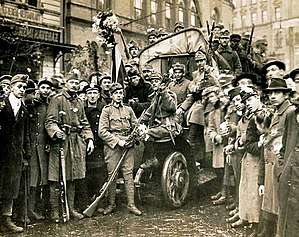Aster Revolution
| Aster Revolution | |||||||
|---|---|---|---|---|---|---|---|
| Part of the aftermath of World War I and the Revolutions of 1917–23 | |||||||
 Revolutionary soldiers wearing aster flowers, 31 October 1918 | |||||||
| |||||||
| Belligerents | |||||||
| Commanders and leaders | |||||||
| |||||||
The Aster Revolution or Chrysanthemum Revolution (Hungarian: Őszirózsás forradalom) was a revolution in Hungary led by Count Mihály Károlyi in the aftermath of World War I which led to the foundation of the short-lived First Hungarian People's Republic.[1][2]
The revolution received its name because the citizens and demobilized soldiers in Budapest began placing the aster flowers (őszirózsa: literally autumn = ősz and rose = rózsa) in their hats and caps to symbolize support for the social democratic Hungarian National Council (HNC) and Count Károlyi.
Károlyi had helped establish the Hungarian National Council which demanded the secession of Hungary from the Austro-Hungarian Empire. In the early morning hours of 31 October 1918, with support of the soldiers from the Hungarian Army, HNC protesters wearing asters helped seize public buildings throughout Budapest. Prime Minister Sándor Wekerle resigned and former Prime Minister István Tisza was murdered.
By the end of the day, King Charles IV was forced to accept the coup and Károlyi became Hungary's new Prime Minister. Károlyi then terminated the Compromise of 1867, thus formally dissolving the Austro-Hungarian union. On 13 November, Charles issued a proclamation recognizing Hungary's right to determine the form of the state and withdrawing from Hungarian affairs of state. Károlyi's provisional government proclaimed the Hungarian People's Republic on 16 November 1918, with Károlyi named as provisional president.
In March 1919, the republic was itself overthrown by a Communist putsch, which established the Hungarian Soviet Republic. Soviet Hungary was soon overthrown by a Romanian invasion and, after a brief revival of the People's Republic, the monarchy was restored, although as an independent country.
History
Timeline

References
- ↑ Cornelius, Deborah S. (2017-02-25). Hungary in World War II: Caught in the Cauldron. Fordham Univ Press. p. 10. ISBN 9780823233434.
- ↑ Rudnytsky, Peter L.; Bokay, Antal; Giampieri-Deutsch, Patrizia (2000-07-01). Ferenczi's Turn in Psychoanalysis. NYU Press. p. 43. ISBN 9780814775455.